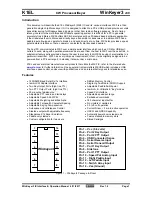
Page 7 of 44
Installation rules
Grounding arrangements
The RS485 Signal Common must be connected directly to protective ground, at one point only for the entire bus.
Generally this point is to be chosen on the master device or on its TAP, preferably using the power supply GND
(negative supply). It is highly recommended that the RS485 interface on the master is chosen to be an isolated
type.
It is not allowed to connect the RS485 Signal Common to the power supply GND at the actuator nodes.
Doing so will cause high ground currents to flow in the « Common » circuit.
Line termination
A reflection in a transmission line is the result of an impedance discontinuity that a travelling wave sees as it
propagates down the line.
To minimise the reflections from the end of the RS485-cable it is required to place a Line Termination (LT) near
each of the 2 ends of the Bus.
The termination is made with a 120 Ohms (0.25 W) resistor (see figure below).
Line biasing
No line biasing is necessary for the LINAK MODBUS actuators to function, as their isolated RS485-transceivers
are true fail-safe, meaning that they correctly handle an idle bus (no enabled driver on the bus).
Cable length and number of slaves
Even though a MODBUS master can logically address up to 247 nodes in a multipoint serial line there are several
parameters that have an influence on the maximum number of slaves in a system.








































